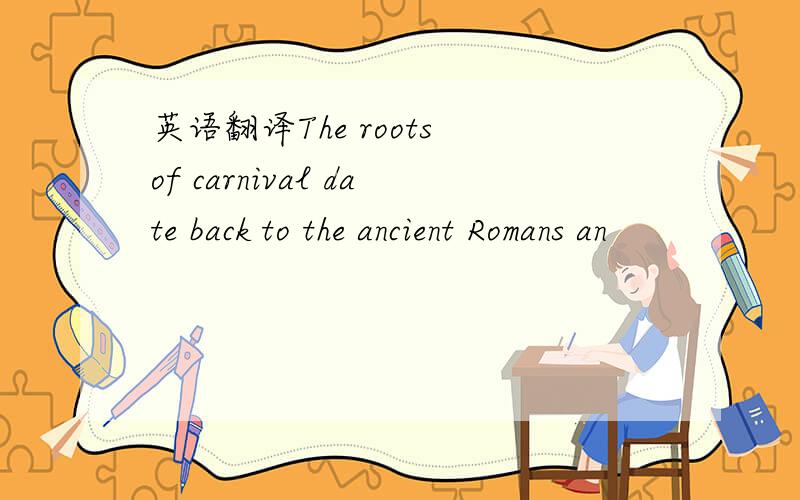英语翻译The roots of carnival date back to the ancient Romans an
来源:学生作业帮 编辑:大师作文网作业帮 分类:综合作业 时间:2024/09/21 00:52:59
英语翻译
The roots of carnival date back to the ancient Romans and Greeks who celebrated the coming of spring.Across Europe,including France,Spain and portugal,people gave thanks every year by throwing parties,wearing masks and dancing in the streets.Such traditions were carried over to the New World.
The portuguesefirstbrought the idea of"celebration or carnival"to Rio be Janeiro around 1850.The practice of holding balls and parties was introduced from paris.however,in brazil,the traditions soon became different.Over time,they got unipue cjaracters coming from African and American Indian cultures.
Groups of people would perform a parade through the streets playing music and dancing.It was usual that during carnival men would cross-dress as women and the poor dress up as the rich—social roles and slass differences were expected to be forgotten once a year but only for the duration of the festival.
It took a loog time before carnival was accepted by the government asanexpression of culture.From then on,the black people actively joined in the celebrations.
By the end of the 18th century the celebrationswereimproved by competitions.People would not just dress up in costumes but also perform aparade accompanied by aband.Theae ever more organized competitions became the main attractions of the carnival in rio.
Until the beginning of the 20th century,the street carnival in Rio was musically a very important event.At the same time,the working class developed their own music.These people weremostly based in thecentral part of Rio,which came to be known as"little Africa"and is now recognized as the cradle of samba.The parades were stopped during World war II and started again in 1947.
Caeinval has gone a long way since it was brought to Rio,having become one of the biggest events in the world.
The roots of carnival date back to the ancient Romans and Greeks who celebrated the coming of spring.Across Europe,including France,Spain and portugal,people gave thanks every year by throwing parties,wearing masks and dancing in the streets.Such traditions were carried over to the New World.
The portuguesefirstbrought the idea of"celebration or carnival"to Rio be Janeiro around 1850.The practice of holding balls and parties was introduced from paris.however,in brazil,the traditions soon became different.Over time,they got unipue cjaracters coming from African and American Indian cultures.
Groups of people would perform a parade through the streets playing music and dancing.It was usual that during carnival men would cross-dress as women and the poor dress up as the rich—social roles and slass differences were expected to be forgotten once a year but only for the duration of the festival.
It took a loog time before carnival was accepted by the government asanexpression of culture.From then on,the black people actively joined in the celebrations.
By the end of the 18th century the celebrationswereimproved by competitions.People would not just dress up in costumes but also perform aparade accompanied by aband.Theae ever more organized competitions became the main attractions of the carnival in rio.
Until the beginning of the 20th century,the street carnival in Rio was musically a very important event.At the same time,the working class developed their own music.These people weremostly based in thecentral part of Rio,which came to be known as"little Africa"and is now recognized as the cradle of samba.The parades were stopped during World war II and started again in 1947.
Caeinval has gone a long way since it was brought to Rio,having become one of the biggest events in the world.

根狂欢节的日期追溯到古罗马人和希腊人谁庆祝春天的到来.在欧洲,包括法国,西班牙和葡萄牙,人们感谢每年的派对,戴着面具,在街上跳舞.这种传统被带到新世界.
该portuguesefirstbrought「庆典或嘉年华”是巴西里约1850左右.实践举办舞会和当事人是从巴黎引进的.然而,在巴西的传统,很快就不同.随着时间的推移,他们有独特的cjaracters来自非洲和美洲印第安人的文化.
人群进行走上街头游行,演奏的音乐和舞蹈.它通常在嘉年华会变装,作为妇女和穷人的换装为丰富-社会角色和玻璃的差异预期被遗忘的一年一次,但只在节日.
它花了很长时间才接受了政府asanexpression狂欢文化.从那时起,黑人们积极参加了庆祝活动.
年底的第十八个世纪celebrationswereimproved的比赛.人们会不只是在服装服饰也进行游行伴随屯兵.茶越来越成为组织竞争的主要景点,在里约狂欢节.
直到第二十个世纪初,街道在里约狂欢节音乐是一个非常重要的事件.同时,工人阶级建立了他们自己的音乐.这些人weremostly在中央部分的里约,后来被称为“非洲”,现在是公认的桑巴舞的摇篮.游行被停止在二战开始再次在1947.
caeinval已经走过了漫长的道路,因为它被带到里约热内卢,具有成为一个最大的事件在世界上
应该就是这个了!
该portuguesefirstbrought「庆典或嘉年华”是巴西里约1850左右.实践举办舞会和当事人是从巴黎引进的.然而,在巴西的传统,很快就不同.随着时间的推移,他们有独特的cjaracters来自非洲和美洲印第安人的文化.
人群进行走上街头游行,演奏的音乐和舞蹈.它通常在嘉年华会变装,作为妇女和穷人的换装为丰富-社会角色和玻璃的差异预期被遗忘的一年一次,但只在节日.
它花了很长时间才接受了政府asanexpression狂欢文化.从那时起,黑人们积极参加了庆祝活动.
年底的第十八个世纪celebrationswereimproved的比赛.人们会不只是在服装服饰也进行游行伴随屯兵.茶越来越成为组织竞争的主要景点,在里约狂欢节.
直到第二十个世纪初,街道在里约狂欢节音乐是一个非常重要的事件.同时,工人阶级建立了他们自己的音乐.这些人weremostly在中央部分的里约,后来被称为“非洲”,现在是公认的桑巴舞的摇篮.游行被停止在二战开始再次在1947.
caeinval已经走过了漫长的道路,因为它被带到里约热内卢,具有成为一个最大的事件在世界上
应该就是这个了!
英语翻译The roots of carnival date back to the ancient Romans an
Date back to the
this proverb comes from the ancient romans
英语翻译The traditions of Christmas date back to long before the
英语翻译The Carnival of Brazil is an annual festival held forty-
英语翻译carnival of rust 歌手:poets of the fall 专辑:carnival of rus
lily have agreed to back date the bill of lading.
The roots of
英语翻译After this date we promise to pay the order of bearer an
英语翻译Day of the DeadThe Day of the Dead is an ancient festiva
英语翻译The success recorder to date of implementing the necessa
up to the date of